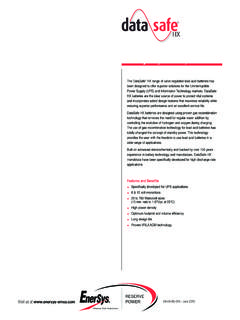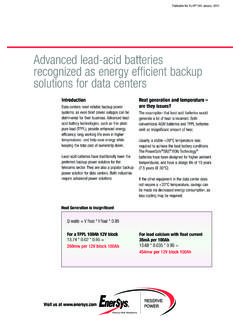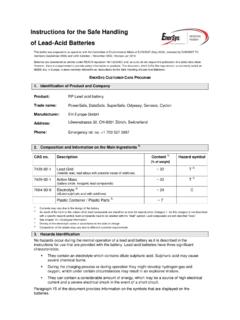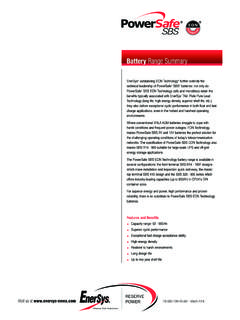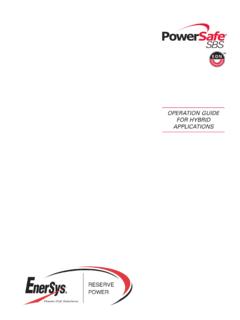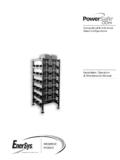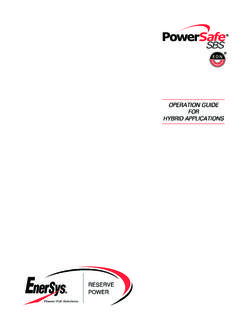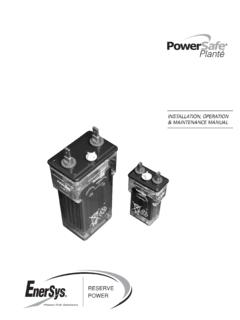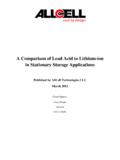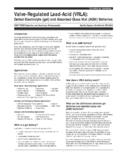Transcription of EUROBAT CUSTOMER ARE ROGRAM …
1 This leaflet was prepared by the Committee of Environmental Affairs of EUROBAT (May 2003), reviewed by EUROBAT TC members (September 2003) and CEM (October November 2003). Revision: December 2016. EUROBAT CUSTOMER CARE PROGRAM INFORMATION FOR THE SAFE HANDLING OF LEAD- acid BATTERIES 1. Identification of Product and Company Product: Reserve Power (RP) Lead acid battery Trade name: PowerSafe, DataSafe, SuperSafe, Odyssey, Genesis, Cyclon Manufacturer: EH Europe GmbH Address: Baarerstrasse 18, 6300 Zug, Switzerland Phone: Emergency tel. no. +1 703 527 3887 2. Hazards Identification No hazards occur during the normal operation of a Lead acid battery as it is described in the instructions for use that are provided with the battery . However, Lead- acid Batteries have three significant characteristics: They contain an electrolyte which contains diluted sulphuric acid . Sulphuric acid may cause severe chemical burns.
2 During the charging process or during operation they might develop hydrogen gas and oxygen, which under certain circumstances may result in an explosive mixture. They can contain a considerable amount of energy, which may be a source of high electrical current and a severe electrical shock in the event of a short circuit. The Batteries may have to be marked with the symbols listed under section 15. 3. Composition and Information on the main Ingredients CAS no. Index Numbers Description Content 1) [% of weight] Hazards Category and Statement Code, GHS pictograms 7439-92-1 082-014-00-7 Lead Grid (Lead massive, lead alloys) ~ 32 Repr. 1A - H360FD Lact H362 STOT RE 1 H372 7439-92-1 082-001-00-6 Active Mass (Lead dioxide, inorganic lead compounds, with possible traces of additives) ~ 32 Repr. 1A - H360Df Acute Tox. 4 - H332, Acute Tox. 4 - H302 STOT RE 1 - H372 Lact H362 H351 Aquatic Acute 1 - H400, Aquatic Chronic 1 H410 7664-93-9 016-020-00- 8 Electrolyte 2) (diluted sulphuric acid with additives) ~ 29 - H 314 Plastic Container / Plastic Parts 3) ~ 7 1) Contents may vary due to performance data and/or application of the battery 2) Density of the electrolyte varies in accordance to the state of charge 3) Composition of the plastic may vary due to different CUSTOMER requirements 4.
3 First Aid measures This information is of relevance only if the battery is broken and this results in a direct contact with the ingredients. General Electrolyte (diluted sulphuric acid ): sulphuric acid acts corrosively and damages skin Lead compounds: lead compounds are classified as toxic for reproduction Electrolyte (Sulphuric acid ) After skin contact: rinse with water, remove and wash wetted clothing After inhalation of acid mist: inhale fresh air, seek advice of a medical doctor After contact with the eyes: rinse under running water for several minutes, seek advice of a medical doctor After swallowing: drink a lot of water immediately, swallow activated carbon, do not induce vomiting, and seek advice of a medical doctor Lead compounds After skin contact: clean with water and soap After inhalation.
4 Inhale fresh air, seek advice of a medical doctor After contact with the eyes: rinse under running water for several minutes, seek advice of a medical doctor After swallowing: wash mouth with water, seek advice of a medical doctor 5. Fire fighting measures Suitable fire extinguishing agents: CO2, dry powder extinguishing agents or Water. Unsuitable fire extinguishing agents: Water, if the battery voltage is above 120 V. Special protective equipment: Protective goggles, respiratory protective equipment, acid protective equipment, acid -proof clothing in case of larger stationary battery plants or where larger quantities are stored. 6. Measures to be taken in case of accidental release This information is of relevance only if the battery is broken and the ingredients are released. In the case of spillage, use a bonding agent, such as sand, to absorb spilt acid ; use lime / sodium carbonate for neutralisation; dispose of with due regard to the official local regulations; do not allow penetration into the sewage system, into earth or water bodies.
5 7. Handling and Storage Store under a roof in cool ambiance - charged lead- acid batteries do not freeze up to -50 C; prevent short circuits. Seek agreement with local water authorities in case of larger quantities of batteries to be stored. If batteries have to be stored, it is imperative that the information for use is observed. 8. Exposure limits and personal protective equipment Lead and Lead compounds No exposure to lead and lead compounds during normal conditions of use. Electrolyte (Sulphuric acid ) Exposure to sulphuric acid and acid mist might occur during filling and charging. Threshold value in workplace: occupational exposure limits for sulphuric acid mist are regulated on a national basis. Hazard corrosive Personal protective equipment: Protective goggles, rubber or PVC gloves, acid -resistant clothing, safety boots.
6 CAS-No: 7664-93-9 Hazard statements: H314 Causes severe burns and eye damage. Precautionary Statements: P102 Keep out of reach of children. P210 Keep away from heat, hot surfaces, sparks, open flames and other ignition sources. No smoking P305+P351+315 IF in eyes. Rinse cautiously with water for several minutes. Get immediate medical advice/attention. P309+315 IF exposed or if you feel unwell. Get immediate medical advice/attention. 9. Physical and Chemical properties Lead and Lead compounds Electrolyte (diluted sulphuric acid , 30 to ) Appearance form : colour : odour : solid grey odourless liquid colourless odourless Safety-related data solidification point : boiling point : solubility in water : density (20 C) : vapour pressure (20 C) : 327 C 1740 C very low ( mg/l) -35 to -60 C approx. 108 to 114 C complete to Lead and Lead compounds used in Lead- acid batteries are poorly soluble in water, Lead can be dissolved in an acidic or alkaline environment only.
7 10. Stability and Reactivity (sulphuric acid , 30 %) Corrosive, non-flammable liquid. Thermal decomposition at 338 C. Destroys organic materials such as cardboard, wood, textiles. Reacts with metals, producing hydrogen. Vigorous reactions on contact with sodium hydroxide and alkalis. 11. Toxicological Information This information does not apply to the finished product Lead- acid battery . This information only applies to its compounds in case of a broken product. Different exposure limits exist on a national level. Electrolyte (diluted sulphuric acid ): Sulphuric acid is intensely corrosive to skin and mucous membranes; the inhalation of mists may cause damage to the respiratory tract. Acute toxicity data: LD50 (oral, rat) = 2140 mg/kg LC50 (inhalation, rat) = 510 mg/m /2h Lead and Lead compounds Lead and its compounds used in a Lead acid battery may cause damage to the blood, nerves and kidneys when ingested.
8 The lead contained in the active material is classified as toxic for reproduction. 12. Ecological Information This information is of relevance if the battery is broken and the ingredients are released to the environment. Electrolyte (diluted sulphuric acid ) In order to avoid damage to the sewage system, the acid has to be neutralised by means of lime or sodium carbonate before disposal. Ecological damage is possible by change of pH. The electrolyte solution reacts with water and organic substances, causing damage to flora and fauna. The electrolyte may also contain soluble components of lead that can be toxic to aquatic environments. Lead and Lead compounds Chemical and physical treatment is required for the elimination from water. Waste water containing lead must not be disposed of in an untreated condition. Lead metal grids are not classified as eco-toxic. 13. Disposal Considerations Spent lead- acid batteries (EWC 160601*) are subject to regulation of the EU battery Directive and its adoptions into national legislation on the composition and end-of-life management of batteries.
9 Spent Lead- acid batteries are recycled in lead refineries (secondary lead smelters). The components of a spent Lead- acid battery are recycled or re-processed. At the points of sale, the manufacturers and importers of batteries, respectively the metal dealers take back spent batteries, and render them to the secondary lead smelters for processing. To simplify the collection and recycling or re-processing process, spent Lead- acid batteries must not be mixed with other batteries. By no means may the electrolyte (diluted sulphuric acid ) be emptied in an inexpert manner. This process is to be carried out by the processing companies only. *200133 EWC may be used for municipal collected batteries. 14. Transport Regulation Flooded Lead- acid batteries: Land Transport Land Transport (ADR/RID) - UN N : UN2794 - Classification ADR/RID: Class 8 - Proper Shipping Name: BATTERIES, WET, FILLED WITH acid electric storage - Packing Group: not assigned - Packaging instruction: P 801 - ADR/RID: New and spent batteries are exempt from all ADR/RID (special provision 598).
10 Sea Transport Sea Transport (IMDG Code) - Classification: Class 8 - UN N : UN2794 - Proper Shipping Name: BATTERIES, WET, FILLED WITH acid electric storage - Packing Group: Not assigned - EmS: F-A, S-B - Packaging instruction: P 801 Air Transport Air Transport (IATA-DGR) - Classification: Class 8 - UN N : UN2794 - Proper Shipping Name: BATTERIES, WET, FILLED WITH acid electric storage - Packing Group: Not assigned - Packaging instruction: P 870 Valve Regulated Lead acid batteries (VRLA): Land Transport Land Transport (ADR/RID, DOT) - UN N : UN2800 - Classification ADR/RID: Class 8 - Proper Shipping Name: BATTERIES, WET, NON SPILLABLE electric storage - Packing Group: not assigned - Packaging instruction: P 801 - ADR/RID: New and spent batteries are exempt from all ADR/RID (special provision 598). Sea Transport Sea Transport (IMDG Code) - UN N : UN2800 - Classification: Class 8 - Proper Shipping Name: BATTERIES, WET, NON SPILLABLE electric storage - Packing Group: Not assigned.
